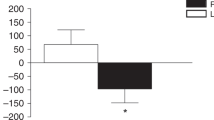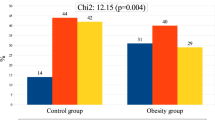Abstract
Background/objectives:
Risk for developing osteoporosis increases in Asia. The purpose of the study was to evaluate the impact of a high-calcium vitamin D fortified milk (HCM) intervention on parathyroid hormone (PTH) levels, vitamin D status and markers of bone turnover in postmenopausal Chinese women.
Subjects/methods:
Sixty three women (>55 years) were assigned to receive two servings of either a calcium/vitamin D fortified milk or a control drink for 12 weeks. PTH, serum 25 (OH)D levels, C-telopeptide of type I collagen (CTX) levels and procollagen type I N-terminal propeptide (PINP) were measured at baseline, 2, 8 and 12 weeks of supplementation.
Results:
Daily calcium intake at baseline ranged between 260 and 482 mg for the HCM, and 252 and 692 mg for the control group. HCM improved serum 25 (OH)D levels significantly (33.13–39.49 nmol/l), while remaining similar in the control group (29.27–28.21 nmol/l). The difference between the groups were significant at week 2, 8 and 12. The percentage change in PTH levels in the HCM group was significant from week 2 onwards compared to the control drink (P<0.017, P<0.05 and P<0.001 at weeks 2, 8 and 12, respectively). Plasma CTX of the HCM group reduced by 25% between weeks 0 and 2, remaining significantly lower and at similar levels up to week 12. The difference between the HCM and control group for PINP reached significance at weeks 8 (P=0.011) and 12 (P=0.003).
Conclusions:
The HCM intervention significantly improved vitamin D status and reduced bone turnover over 12 weeks in postmenopausal Chinese women.
This is a preview of subscription content, access via your institution
Access options
Subscribe to this journal
Receive 12 print issues and online access
$259.00 per year
only $21.58 per issue
Buy this article
- Purchase on Springer Link
- Instant access to full article PDF
Prices may be subject to local taxes which are calculated during checkout





Similar content being viewed by others
References
Lau EM, Lee JK, Suriwongpaisal P, Saw SM, Das DS, Khir A et al. The incidence of hip fracture in four Asian countries: The Asian Osteoporosis Study (AOS). Osteoporos Int 2001; 12: 239–243.
Suzuki T . Risk factors for osteoporosis in Asia. J Bone Min Metab 2001; 19: 133–141.
Dhingra V, Lau E . The Asian Audit: Epidemiology, costs and buren of osteoporosis in Asia 2009 2009: International Osteoporosis Foundation: Nyon, Switzerland. Accessible at www.iofbonehealth.org/bonehealth/asian-audit.
Woo JW, Lau W, Ling X, Lam CWK, Zhao X, Yu W, Pocock N et al. Milk supplementation and bone health in young adult Chinese women. J Women’s Health 2007; 169: 692–702.
Heaney RP . Ethnicity, bone status and the calcium requirement. Nutr Res 2002; 22: 153–178.
Chee WSS, Suriah AR, Chan SP, Zaitun Y . The effect of milk supplementation on bone mineral density in postmenopausal Chinese women in Malaysia. Osteoporosis Int 2003; 14: 828–834.
Hu JF, Zhao X-H, Jia J-B, Parpia B, Campbell TC . Dietary calcium and bone density among middle-aged and elderly women in China. Am J Clin Nutr 1993; 58: 219–227.
Lau EMC, Woo J, Lam V, Hong A . Milk supplementation of the diet of postmenopausal Chinese women on a low calcium intake retards bone loss. J Bone Min Res 2001; 16: 1704–1709.
Lau EMC, Lynne H, Chan YH, Woo J . Milk supplementation prevents bone loss in postmenopausal Chinese women over 3 years. Bone 2002; 31: 536–540.
Du XD, Zhu K, Trube A, Zhang Q, Ma G, Hu X, Fraser DR, Greenfiled H . School-milk intervention trial enhances growth and bone mineral accretion in Chinese girls aged 1-12 years in Beijing. Br J Nutr 2004; 92: 159–168.
Delmas PD, Eastell R, Garnero P, Seibel MJ, Stepan J . The use of biochemical markers of bone metabolism in osteoporosis. Osteoporosis Int 2000; 6: S2–S17.
Pi Y-Z, Wu X-P, Liu S-P . Age-related changes in bone biochemical markers and their relationship with bone mineral density in normal Chinese women. J Bone Min Res 2006; 24: 380–385.
Garnero P, Haussher E, Chapuy MC, Marcelli C, Grandjean H, Muller C et al. Markers of bone resorption predicts hip fracture risk in elderly women. The EPIDOS Prospective Study. J Bone Min Res 1996; 11: 1531–1538.
Kruger MC, Schollum LMS, Kuhn-Sherlock B, Hestiantoro A, Wijanto P, Li-Yu J et al. The effect of a fortified milk drink on vitamin D status and bone turnover in post-menopausal women from South East Asia. Bone 2010; 46: 759–767.
Angeles-Agdeppa I, Capanzana MV, Li-Yu J, Schollum LM, Kruger MC . High calcium milk prevents overweight and obesity among postmenopausal women. Food Nutr Bull 2010; 31: 381–390.
Woo J, Lam CWK, Leung J, Lau WY, Lau E, Ling X et al. Very high rates of vitamin D insufficiency in women of child bearing age living in Hong Kong and Beijing. Br J Nutr 2008; 99: 1330–1334.
Heaney RP, Dowell MS, Hale CA, Bendich A . Calcium absorption varies within the reference range for serum 25-hydroxyvitamin D. J Am Coll Nutr 2003; 22: 142–146.
Dawson-Hughes B, Heaney RP, Holick MF, Lips P, Meunier PJ, Vieth R . Estimates of optimal vitamin D status. Osteoporos Int 2005; 16: 713–716.
Wat WZM, Leung JYY, Tam S, Kung AWC . Prevalence and impact of vitamin D insufficiency in Southern Chinese adults. Annals Nutr Metab 2007; 51: 59–64.
Yan L, Prentice A, Zhang H, Stirling DM, Golden MM . Vitamin D status and parathyroid hormone concentrations in Chinese women and men from north-east of the People′s Republic of China. Eur J Clin Nutr 2000; 54: 68–72.
Bischoff-Ferrari HA, Kiel DP, Dawson-Hughes B, Orav JE, Li R, Spiegelman D et al. Dietary calcium and serum 25-hydroxyvitamin D status in relation to BMD among U.S. adults. J Bone Min Res 2009; 24: 935–942.
Garnero P, Munoz F, Sornay-Rendu E, Delmas PD . Associations of vitamin D status with bone mineral density, bone turnover, bone loss and fracture risk in healthy postmenopausal women. The OFELY study. Bone 2007; 40: 716–722.
Macdonald HM, Mavroeidi A, Barr RJ, Black AJ, Fraser WD, Reid DM . Vitamin D status in postmenopausal women living at higher latitudes in the UK in relation to bone health, overweight, sunlight exposure and dietary vitamin D. Bone 2008; 42: 996–1003.
Nakamura K, Tsugawa N, Saito T, Ishikawa M, Tsuchiya Y, Hyodo K et al. Vitamin D status, bone mass and bone metabolism in home dwelling postmenopausal Japanese women: Yokogoshi Study. Bone 2008; 42: 271–277.
Rejnmark L, Vestergaard P, Brot C, Mosekilde L . Parathyroid hormone response to vitamin D insufficiency: relations to bone, body composition and to lifestyle characteristics. Clin Endocrinol 2008; 69: 29–35.
Kuchuk NO, Van Schoor NM, Pluijm SM, Chines A, Lips P . Vitamin D status, parathyroid function, bone turnover, and BMD in postmenopausal women with osteoporosis: a global perspective. J Bone Min Res 2009; 24: 693–701.
Nordin BEC . The role of vitamin D deficiency in hip fractures. Nutr Abstracts Rev 2005 series A 75: 33N–44N.
Dawson-Hughes B, Mithal A, Bonjour J-P, Boonen S, Burckhardt P, Fuleihan GEH et al. IOF position statement: vitamin D recommendations for older adults. Osteoporos Int 2010; 21: 1151–1154.
Zhang H, Huang Q, Zhang Z-L . The efficacy of calcitriol and vitamin D3 supplementation on calcium metabolism and bone turnover markers in Shanghai postmenopausal women. Bone 2010; 47: S427.
Trento LK, Pietropolli A, Ticconi C, Gravotta E, De Martino MU, Fabbri A et al. Role of type I collagen C telopeptide, bone specific alkaline phosphatase and osteocalcin in the assessment of bone status in postmenopausal women. J Obstet Gymaecol Res 2009; 35: 152–159.
Glover SJ, Garnero P, Naylor K, Rogers A, Eastell R . Establishing a reference range for bone turnover markers in young, healthy women. Bone 2008; 42: 623–630.
Glover SJ, Gall M, Schoenborn-Kellenberger O, Wagener M, Garnero P, Boonen S et al. Establishing a reference interval for bone turnover markers in 637 healthy young premenopausal women form the United Kingdom, France, Belgium and the United States. J Bone Min Res 2009; 24: 389–397.
Liu S, Tian L-F, Xu P, Zhuang G-H, Zheng F, Tian J et al. Analysis of correlation between blood biochemical indicators and bone mineral density of postmenopausal women. Mol Biol Rep 2011; 38: 939–948.
Hill TR, O’Brien MM, Lamberg-Allardt C, Jakobsen J, Kiely M, Flynn A et al. Vitamin D status of 51-75 year old Irish women: its determinants and impact on biochemical indices of bone turnover. Public Health Nutr 2006; 9: 225–233.
Need AG . Bone resorption markers in vitamin D insufficiency. Clin Chem Acta 2006; 368: 48–52.
Szulc P, Delmas PD . Biochemical markers of bone turnover: potential use in the investigation and management of postmenopausal osteoporosis. Osteoporos Int 2008; 19: 1683–1704.
Huang OR, Lu JH, Zhou Q, Liu YJ, Wang QH . Effect of calcium and vitamin D supplementation on bone loss in postmenopausal Chinese women: a comparative study. Osteoporos Int 2000; 11: S183.
Löfman O, Magnusson P, Toss G, Larsson L . Common biochemical markers of bone turnover predict future bone loss: a 5 year follow-up study. Clin Chim Acta 2005; 356: 67–75.
Eastell R, Hannon RA . Biomarkers of bone health and osteoporosis risk. Proceedings Nutr Soc 2008; 67: 157–162.
Larsen ER, Mosekilde L, Foldspang A . Vitamin D and calcium supplementation prevents osteoporotic fractures in elderly community dwelling residents: a pragmatic population-based 3-year intervention study. J Bone Min Res 2004; 19: 370–378.
Boonen S, Lips P, Bouillon R, Vanderschueren D, Haentjens P . Need for additional calcium to reduce the risk of hip fracture with vitamin D supplementation: evidence from a comparative meta-analysis of randomised controlled trials. J Clin Endocrinol Metab 2007; 92: 1415–1423.
Tang BMP, Eslick GD, Nowson C, Bensoussan AB . Use of calcium in combination of vitamin D supplementation to prevent fractures and bone loss in people aged 50 years and older: a meta-analysis. Lancet 2007; 370: 657–666.
Acknowledgements
This study was funded by Fonterra Brands, Singapore PTE Ltd.
Author information
Authors and Affiliations
Corresponding author
Ethics declarations
Competing interests
LM Schollum, B Kuhn-Sherlock and JM Todd are employees of Fonterra Cooperative Group Ltd, New Zealand.
Rights and permissions
About this article
Cite this article
Kruger, M., Ha, P., Todd, J. et al. High-calcium, vitamin D fortified milk is effective in improving bone turnover markers and vitamin D status in healthy postmenopausal Chinese women. Eur J Clin Nutr 66, 856–861 (2012). https://doi.org/10.1038/ejcn.2012.54
Received:
Revised:
Accepted:
Published:
Issue Date:
DOI: https://doi.org/10.1038/ejcn.2012.54
Keywords
This article is cited by
-
Dairy products and bone health
Aging Clinical and Experimental Research (2021)
-
Systematic review and meta-analysis of the association between dairy consumption and the risk of hip fracture: critical interpretation of the currently available evidence
Osteoporosis International (2020)
-
Calcium and vitamin D fortified milk reduces bone turnover and improves bone density in postmenopausal women over 1 year
European Journal of Nutrition (2018)
-
Tocotrienol supplementation suppressed bone resorption and oxidative stress in postmenopausal osteopenic women: a 12-week randomized double-blinded placebo-controlled trial
Osteoporosis International (2018)
-
Benefits and safety of dietary protein for bone health—an expert consensus paper endorsed by the European Society for Clinical and Economical Aspects of Osteopororosis, Osteoarthritis, and Musculoskeletal Diseases and by the International Osteoporosis Foundation
Osteoporosis International (2018)



